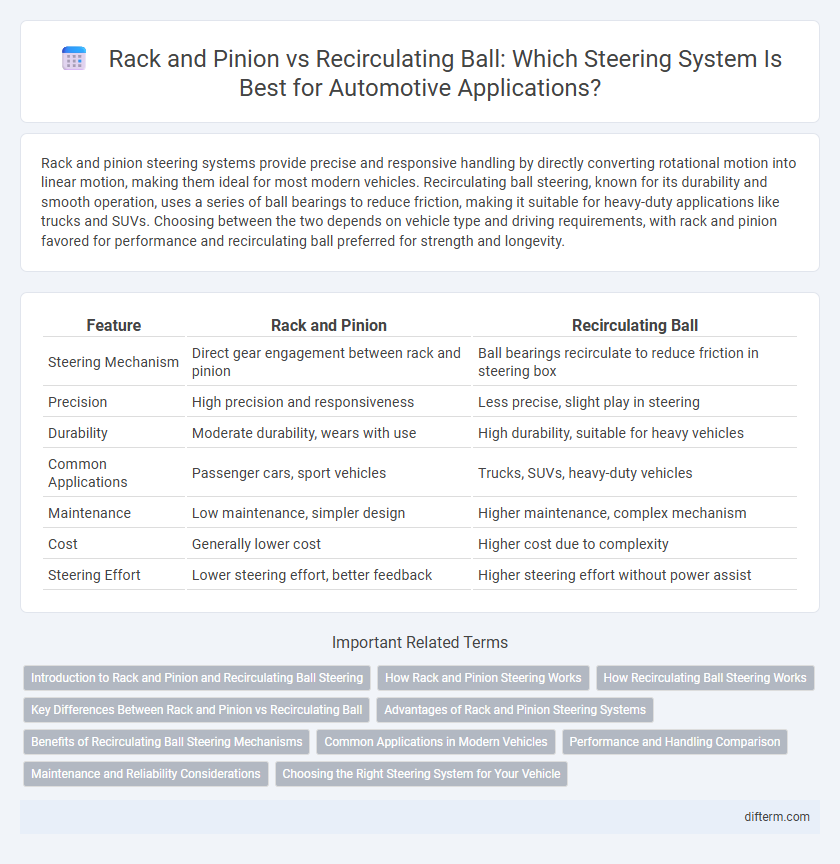Rack and pinion steering systems provide precise and responsive handling by directly converting rotational motion into linear motion, making them ideal for most modern vehicles. Recirculating ball steering, known for its durability and smooth operation, uses a series of ball bearings to reduce friction, making it suitable for heavy-duty applications like trucks and SUVs. Choosing between the two depends on vehicle type and driving requirements, with rack and pinion favored for performance and recirculating ball preferred for strength and longevity.
Table of Comparison
| Feature | Rack and Pinion | Recirculating Ball |
|---|---|---|
| Steering Mechanism | Direct gear engagement between rack and pinion | Ball bearings recirculate to reduce friction in steering box |
| Precision | High precision and responsiveness | Less precise, slight play in steering |
| Durability | Moderate durability, wears with use | High durability, suitable for heavy vehicles |
| Common Applications | Passenger cars, sport vehicles | Trucks, SUVs, heavy-duty vehicles |
| Maintenance | Low maintenance, simpler design | Higher maintenance, complex mechanism |
| Cost | Generally lower cost | Higher cost due to complexity |
| Steering Effort | Lower steering effort, better feedback | Higher steering effort without power assist |
Introduction to Rack and Pinion and Recirculating Ball Steering
Rack and pinion steering delivers precise control by converting rotational motion of the steering wheel directly into linear motion of the wheels, making it ideal for modern passenger vehicles. Recirculating ball steering, commonly found in trucks and heavy-duty vehicles, uses a worm gear and ball bearings to reduce friction and provide greater torque for managing heavier loads. Understanding the mechanical differences highlights rack and pinion's responsiveness versus recirculating ball's durability under high-stress conditions.
How Rack and Pinion Steering Works
Rack and pinion steering operates by converting the rotational motion of the steering wheel into linear motion via a circular gear (pinion) engaging with a linear gear (rack), directly controlling the vehicle's wheels. This system provides precise and responsive steering, making it common in modern vehicles for improved handling and control. Rack and pinion's simplicity and efficiency enhance driver feedback and reduce steering effort compared to recirculating ball mechanisms.
How Recirculating Ball Steering Works
Recirculating ball steering operates by using a worm gear mechanism where ball bearings circulate inside the gear to reduce friction and wear, translating the steering wheel's rotation into lateral movement of the steering linkage. This system enhances durability and provides smoother steering feedback compared to rack and pinion, especially in heavy-duty vehicles. The precise movement of the balls within the worm gear ensures efficient torque transfer and minimizes mechanical play for better control.
Key Differences Between Rack and Pinion vs Recirculating Ball
Rack and pinion steering provides direct and precise control by converting rotational motion of the steering wheel into linear motion with fewer components, resulting in quicker response times compared to recirculating ball systems. Recirculating ball steering uses a series of ball bearings within a worm gear mechanism to reduce friction and handle higher loads, offering durability and smoother steering in heavy-duty vehicles. The key difference lies in the rack and pinion's simplicity and accuracy versus the recirculating ball's strength and reduced wear for larger, heavier vehicles.
Advantages of Rack and Pinion Steering Systems
Rack and pinion steering systems offer precise and responsive handling, providing drivers with enhanced control and better feedback from the road. Their simpler design reduces weight and complexity, resulting in lower maintenance costs and improved fuel efficiency. These systems are also more compact, making them ideal for modern vehicles where space optimization is crucial.
Benefits of Recirculating Ball Steering Mechanisms
Recirculating ball steering mechanisms offer enhanced durability and reduced steering effort, making them ideal for heavy-duty vehicles and trucks. Their design minimizes friction by recirculating steel balls within the steering gear, resulting in smoother operation and increased longevity compared to rack and pinion systems. This robust construction also provides better resistance to wear and tear, ensuring reliable performance under high-load conditions.
Common Applications in Modern Vehicles
Rack and pinion steering systems are predominantly used in modern passenger cars and light trucks due to their precision and direct response, enhancing overall vehicle handling and maneuverability. Recirculating ball steering mechanisms are more commonly found in heavier vehicles such as SUVs and pickup trucks, where durability and the ability to handle higher steering loads are essential. Both systems play crucial roles in the automotive industry by catering to different performance and design requirements based on vehicle class.
Performance and Handling Comparison
Rack and pinion steering systems deliver more precise and responsive handling, offering direct feedback and quicker steering response, ideal for performance-focused vehicles. Recirculating ball systems provide smoother operation with less wear, but tend to feel less sharp and more sluggish, making them better suited for heavier vehicles requiring durability over agility. The choice between the two impacts steering accuracy and driver control, directly influencing overall vehicle performance and handling characteristics.
Maintenance and Reliability Considerations
Rack and pinion steering systems generally require less maintenance and offer higher reliability due to their simpler design and fewer moving parts compared to recirculating ball systems. Recirculating ball steering mechanisms involve more components, such as the ball bearings and worm gear, which can wear out and necessitate more frequent inspections and lubrication. When evaluating long-term maintenance costs and system durability, rack and pinion is typically favored for its consistent performance and lower likelihood of mechanical failure.
Choosing the Right Steering System for Your Vehicle
Selecting the right steering system for your vehicle depends on factors like driving style, vehicle size, and performance needs. Rack and pinion steering offers precise control and responsiveness, ideal for passenger cars and sports vehicles, while recirculating ball systems provide durability and smooth operation, preferred in trucks and heavy-duty vehicles. Understanding the balance between accuracy, maintenance, and load capacity is crucial for optimizing steering performance and safety.
rack and pinion vs recirculating ball Infographic

 difterm.com
difterm.com